| |
The
Making of a Flame Job - Part 3
by Frank Colgoni |
| |
|
|
|
As I mentioned at the conclusion of part 2 (day 2), this should
be an exciting part of the process. We’re going to get to
see our flames come alive in colour.
Speaking
of colour, I mentioned in the first article of the flame series
that we would be following a traditional layout but not following
a traditional colour progression (or gradient). Traditional progressions
typically start with white or yellow moving to yellow or orange
then to a variation of red or magenta. While I like traditional
progressions, I don’t particularly like them on red cars.
Therefore, we decided to do something different. Specifically,
reverse the progression entirely. That is, begin with red (in
this case, the body colour, then move to a dark orange (Ultra
Orange), then to a lighter orange (Tangelo) then yellow (Sunset)and
finally white (Pearl White). Everything will be outlined in process
blue. Ron was receptive to this idea. In fact, he’s done
a variation of this before (look for a killer late model F150
done this way).
To
begin, Ron applied some base white to the rear section of the
flames where the lighter colours will be applied. The body colour
will act as the base for the red and dark orange. After the application
of the base white, Ron applied a fresh coat of body red to the
rad shell and the area directly behind the shell on the hood and
hood sides. He then moved to the back again and started applying
Sunset Yellow sweeping from the back to the front. Next came the
Tangelo with the same back to front sweep and finally Ultra Orange
as the final fade to red.
|
| |
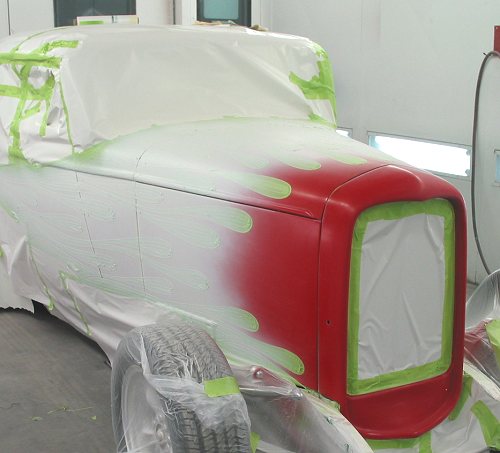 The
white base coat goes on toward the rear of the layout.
The
white base coat goes on toward the rear of the layout. |
| |
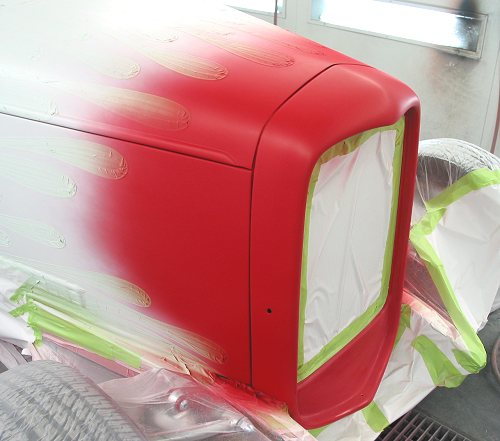 Then,
a splash of the body base red.
Then,
a splash of the body base red. |
| |
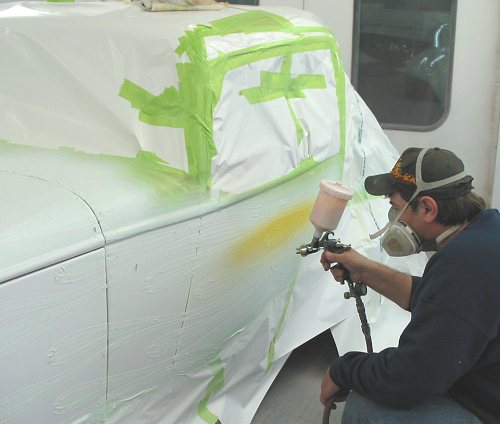 To
the back again to start the Sunset Yellow.
To
the back again to start the Sunset Yellow. |
| |
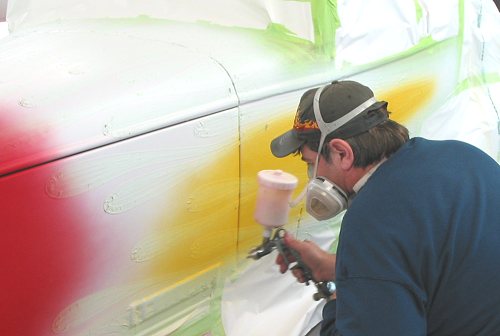
Ron
works his way toward the front until he feels he's gone far enough
into the area where the dark and lighter orange colours will transition.
|
| |
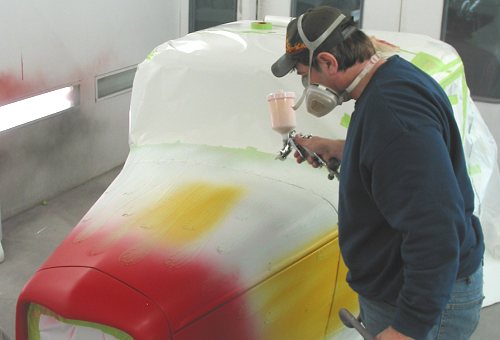 Then
comes the hood. Again, with Sunset Yellow.
Then
comes the hood. Again, with Sunset Yellow. |
| |
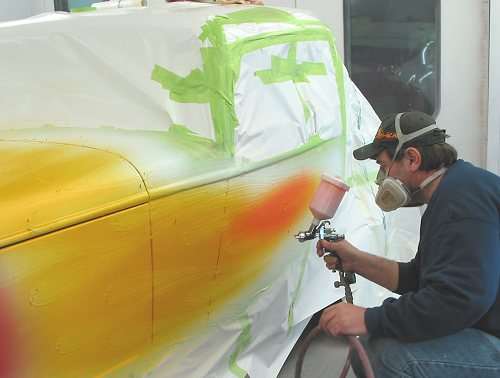 Next
comes the Tangelo. Ron is working from back to front.
Next
comes the Tangelo. Ron is working from back to front. |
| |
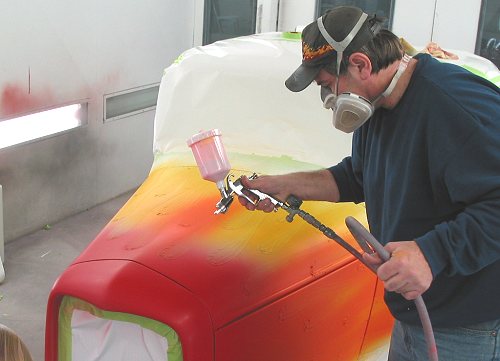 After
completing the side, he moves to the hood.
After
completing the side, he moves to the hood.
There is still one additional colour to come. |
| |
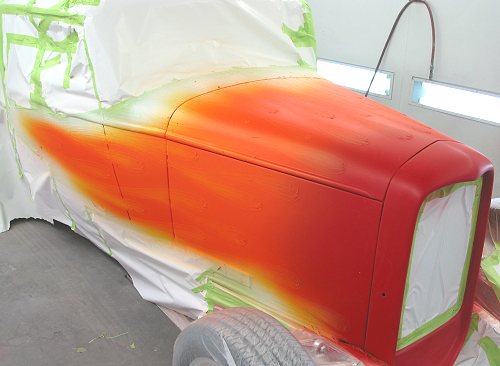 At
this point, Ron has layed down Sunset Yellow and Tangelo.
At
this point, Ron has layed down Sunset Yellow and Tangelo.
Remember that the red on the nose is the body colour. |
| |
Needless
to say, this is not a quick process as some drying is required between
colour hits as well as cleanup of equipment between colours. Also,
Ron is careful to tack everything between colours as paint “dust”
will have settled. |
| |
 Ron
tacks off after the Tangelo.
Ron
tacks off after the Tangelo. |
| |
 Finally,
the Ultra Orange goes down. It is quite dark.
Finally,
the Ultra Orange goes down. It is quite dark.
As such, it will make the final transition to red. |
| |
Ron
advises at this point that the entire process will need to be done
again as the way to get a seamless gradient (perfect transition
from colour to colour) is to apply the colours again but to spray
in the opposite direction than was applied in the first coat. In
other words, if you sprayed the colours from back to front on the
first pass, spray front to back on the second. Additionally, sweep
in the opposite direction.
As
you can imagine, after this many colour changes, things were getting
pretty busy in the area being sprayed. In some ways it’s a
leap of faith to try to visualize the finished product. Ron says
it’s going to be very cool and I trust him. |
| |
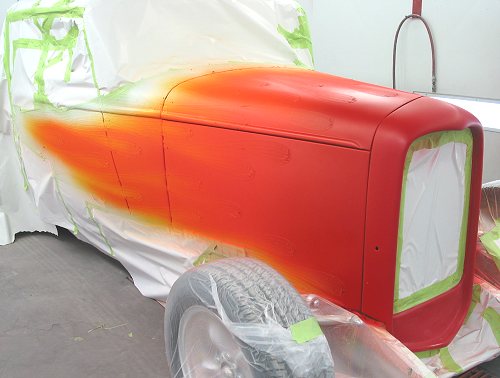 At
this point, two passes have been made through all colours.
At
this point, two passes have been made through all colours.
Including the white base and body red, that's 8 colour changes so
far.
|
| |
To
complete the colour, Ron will add white pearl to define the tips. |
| |
 White
pearl being added to the tips of the door licks.
White
pearl being added to the tips of the door licks. |
| |
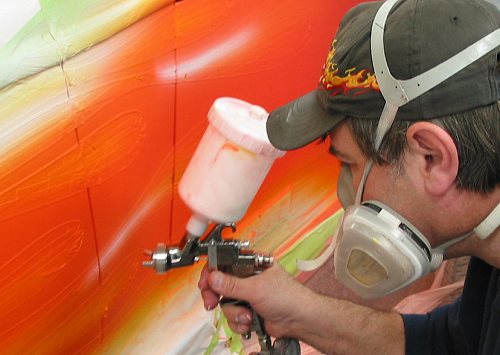 Ron
progresses to other tips.
Ron
progresses to other tips. |
| |
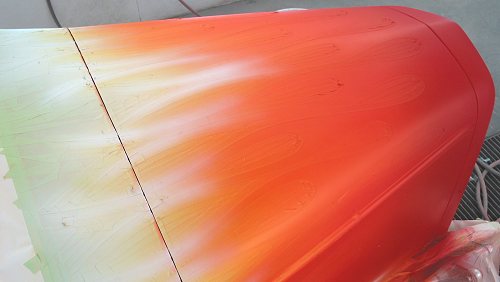 Finally,
the hood.
Finally,
the hood. |
| |
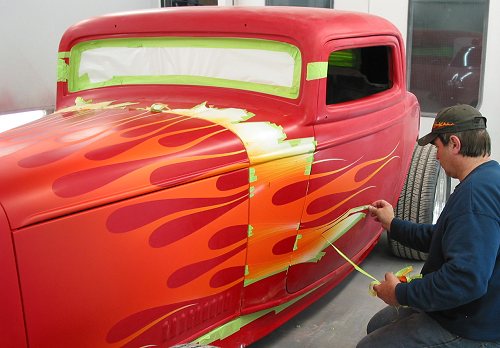 After
a suitable drying time, all the tape and masking paper comes off.
After
a suitable drying time, all the tape and masking paper comes off.
Ron pulls the tape away at a 45 deg. angle. from the surface. |
| |
Despite
a lot of work in this session, we’re not finished yet. Ron is
going to add “drop shadowing”. Drop shadows are commonly
used in conjunction with printed and computer generated graphics to
give the illusion of the object or text hovering above the surface.
On paint, a similar effect is created and can, in fact, be more intense
because you get to view the effect from different angles. Under a
smooth, well polished clear coat, the effect is amazing (caveat here:
IF the drop shadow is done correctly and with the right touch). The
drop shadows are applied using an air brush and Ron mixes up a combination
of our body colour (base red), black and intercoat clear or a base
clear so that the shadow is subtle, not too intense and natural looking.
The addition of clear gives a natural transparency to the shadow.
This
step is not for the faint of heart or shaky of hand. In some areas,
like the inside curves, it’s necessary to get close to the
flame without getting the shadow colour on the flame. And, below
the licks, the shadow has to flow and can’t be applied with
jerky movement or out of alignment.
|
| |
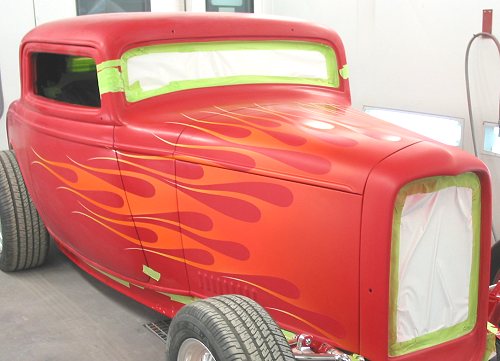 With
all the tape off, here's the way things look - without the drop
shadows.
With
all the tape off, here's the way things look - without the drop
shadows. |
| |
 With
a steady hand, Ron begins the shadowing process.
With
a steady hand, Ron begins the shadowing process. |
| |

The sense of depth is noticeable immediately.
It's amazing how far the small amount of paint in the air brush
bowl will go. |
| |
 Look
just above the arrow. Ron has just made a first
Look
just above the arrow. Ron has just made a first
pass to add a shadow beneath the lick. |
| |
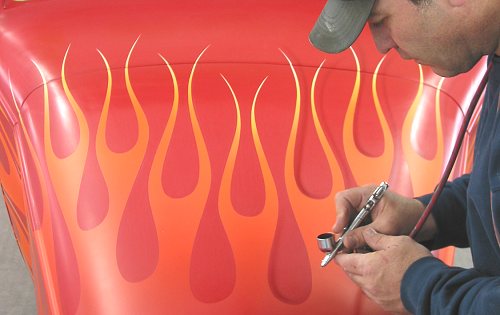 In
this shot, you can compare no shadow (left)
In
this shot, you can compare no shadow (left)
versus with shadow (right). |
| |
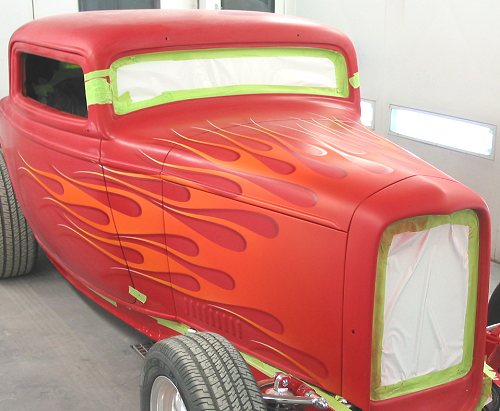 Shadowing
completed. Scroll up five photos to view the before shot.
Shadowing
completed. Scroll up five photos to view the before shot. |
| |
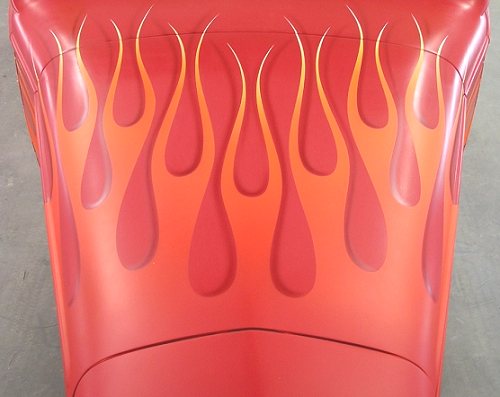 The
completed hood. The layout is a thing of beauty.
The
completed hood. The layout is a thing of beauty.
While I say complete, stay tuned for part 4. |
| |
This
has been a very long day for Ron. A fascinating process to watch.
Wouldn’t have missed any part of this. |
| |
|
| |
|

